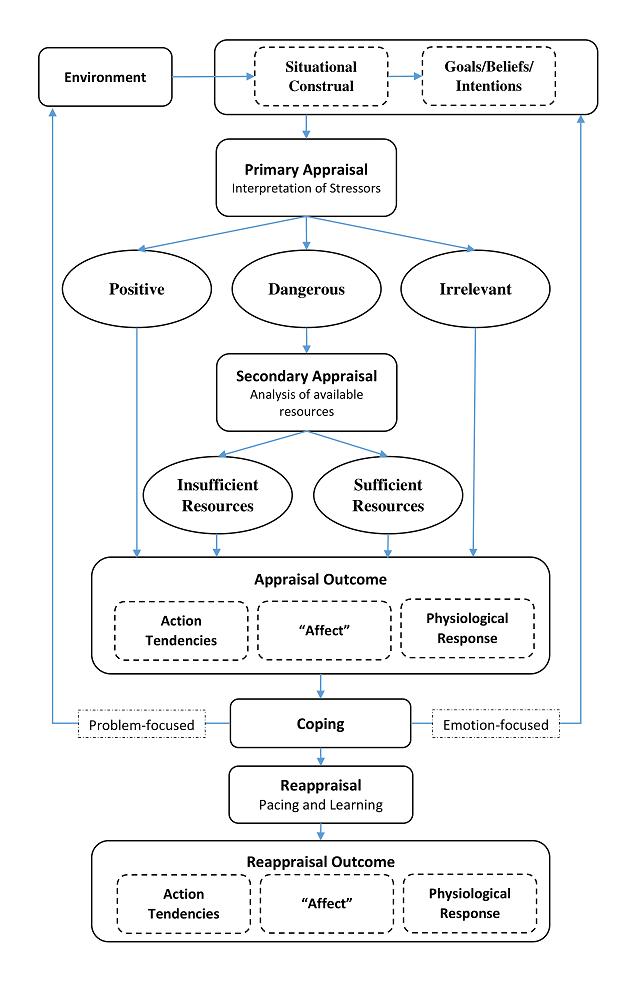Appraisal Theory
Acronym
Acronyms are not commonly used for appraisal theory
Alternate name(s)
Cognitive Appraisal Theory – CAT, Appraisal Theory of Emotions
Main dependent construct(s)/factor(s)
Affect; Emotion Quality and Intention
Main independent construct(s)/factor(s)
Appraisal variables: Relevance, Desirability, Causal Attribution such as agency or blame/credit, Likelihood, Unexpectedness, Urgency, Ego Involvement, Coping Potential such as Controllability, Changeability, Power, Adaptability
Concise description of theory
Appraisal theory of emotions is a theoretical framework which explains emotions are triggered by the individual’s evaluation of events which enables certain reactions. These reactions vary among different people as per their interpretations and explanations of the circumstances (Scherer, 2001). Magda Arnold put the foundation explaining the triggers of emotions through appraisal of situations and specified that it is the first step in emotion in her work “cognitive theory” (Arnold, 1960) (Arnold, Emotion and personality: Vol. 2., 1960). Further advancement of her work suggests that initial appraisals begin the emotional sequences leading to specific actions and emotional experiences as well. The physiological changes accompany the actions and experiences (Arnold, Feelings and emotions: The Loyola Symposium, 1970).
Continuing with the works by Magda Arnold, Richard Lazarus developed the theory to explain long range and immediate outcomes in a stressful-person environment relations with mediators as cognitive appraisal and coping processes. Cognitive appraisal process can be described in two appraisal methods. In primary appraisal, an individual evaluates risks and stakes under certain personal-environment relations. In secondary appraisal, an individual evaluates the resources available with him to further develop coping mechanism. These appraisals converge to whether a transaction with environment is significant for an individual’s well-being and categorised as threatening and challenging (Susan Folkman, 1986).
Coping is defined as individual’s constantly changing cognitive and behavioral efforts to handle person-environment transactions appraised as exceeding the available resources of an individual. Coping helps to regulate stressful emotions referred to as emotion-focused coping and to alter the stressful person-environment relation causing the stress described as problem-focused coping. Coping is process oriented, contextual and makes no a priori differentiation between bad and good coping mechanism (Lazarus, 1991).
Diagram/schematic of theory
Originating author(s)
Joseph B. Walther (1992)
Seminal articles
Walther, J. B. (1992). Interpersonal Effects in Computer-Mediated Interaction: A Relational Perspective. Communication Research, 19(1), 52-90 https://doi.org/10.1177/009365092019001003 Walther, J. B. (1994). Anticipated ongoing interaction versus channel effects on relational communication in computer‐mediated interaction. Human Communication Research, 20, 473–501. doi:10.1111/j.1468‐2958. 1994.tb00332.x Walther, J. B., & Burgoon, J. K. (1992). Relational communication in computer‐mediated interaction. Human Communication Research, 19, 50–88. doi: 10.1111/j.1468‐2958. 1992.tb00295.x
Originating area
Interpersonal communication and media studies
Level of analysis
Individual
Links to WWW sites describing theory
https://en.wikipedia.org/wiki/Social_information_processing_(theory), Wikipedia entry on Social information processing theory
Links from this theory to other theories
Social identification/de‐individuation (SIDE) model of CMC, Social presence theory
IS articles that use the theory
Antheunis, M., Valkenburg, P. M., & Peter, J. (2010). Getting acquainted through social network sites: Testing a model of online uncertainty reduction and social attraction. Computers in Human Behavior, 26, 100–109. doi: 10.1016/j.chb.2009.07.005 Tidwell, L. C., & Walther, J. B. (2002). Computer‐mediated communication effects on disclosure, impressions, and interpersonal evaluations: Getting to know one another a bit at a time. Human Communication Research, 28, 317–348. doi: 10.1111/j.1468‐2958. 2002.tb00811.x Walther, J. B., & D’Addario, K. P. (2001). The impacts of emoticons on message interpretation in computer‐mediated communication. Social Science Computer Review, 19, 323–345. doi: 10.1177/089443930101900307 Walther, J. B., Loh, T., & Granka, L. (2005). Let me count the ways: The interchange of verbal and nonverbal cues in computer‐mediated and face‐to‐face affinity. Journal of Language and Social Psychology, 24, 36–65. doi: 10.1177/0261927X04273036 Walther, J. B., Van Der Heide, B., Ramirez, A. Jr., et al. (2015). Interpersonal and hyperpersonal aspects of computer‐mediated communication. In S. S. Sundar (Ed.), The handbook of psychology and communication technology(pp. 3–22). Oxford, UK: Wiley Blackwell. Wang, Z., Walther, J. B., & Hancock, J. T. (2009). Social identification and interpersonal communication in computer‐mediated communication: What you do versus who you are in virtual groups. Human Communication Research, 35, 59–85. doi:10.1111/j.1468‐2958.2008.01338.x Wilson, J. M., Straus, S. G., & McEvily, B. (2006). All in due time: The development of trust in computer‐mediated and face‐to‐face teams. Organizational Behavior and Human Decision Processes, 99, 16–33. doi: 10.1016/j.obhdp.2005.08.001
Contributor(s)
Ben Krishna, Doctoral Student at Indian Institute of Management, Kozhikode, India
Date last updated
18/12/2019 Please feel free to make modifications to this site. In order to do so, you must register.
